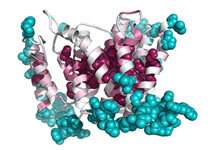Chem 331 Biochemistry
| SS |
Office Hours Mon 10:10; Tues 10:00 & 2:30; Wed 1:30, Friday 1:30 All office hours are in person - request in remote in advance. Scroll to the bottom of this page for assignments and other links!!!! |
Class Notes |
Chapter |
Suggested Readings, Handouts & Chapter Questions |
Learning Objectives & Study Guides |
| Introduction | 1 | Chapter 1 (1.3 &1.4) Chapter 14 (14.2 & 14.3) The Only Two Equations You Will Need ... REQUIRED for Thermo Homework |
|
| Chemical Bonds, Thermodynamics, Equilibrium, Acid Base, Buffers and Blood Buffers |
2 |
Chapter 2 (all) Important - Box 2-2 and web tutorial Suggested problems Chpt 2 (10, 12, 14-16, 18, 26, 29, 31) |
|
Nucleic Acid Structure and Molecular Techniques Link on PCR Polymerase Restriction Enzyme (traditional) Cloning
|
3 & 24 | 3 all, 24.1-24.3 Hoogstein DNA Pairs (wiki) suggested problems: Chpt 3 (9, 10, 12, 18-21, 25, 29, 31, 32, 35, 37) Chpt 24 (7, 8, 9, 13, 30, 33, 34) |
Nucleotides |
|
|||
4
|
Required Readings Chapter 4 (all) Chapter 5 (1 & 2) Chapter 6 TBA Chpt 6 ( 3, 7, 8, 10,12, 17, 20, 23-25, 31, 32) |
|
|
Videos on: Purification Stratagies; Gel Chrom (Vid 1) |
Protein Purif | ||
|
|||
Carbohydrates |
8 |
Suggested Probs 12, 14, 16, 17, 18, 22, 26, 26 |
Carbohydrate |
| 9 | Sugested Probs 1,3,9,12,15,17,19 |
Lipids | |
|
|
||
| Enzyme Kinetics | 12 |
Suggested Probs: 7-20, 25-28 |
Enz Kinetics |
| Enzyme Mechanism and Regulation | 11, 12,13 | Sections required Chpt 11 1 (A,B,C), 3 (A-E but not the enzyme examples like not RNaseA), 5 (A-C). Chpt 12 1(B, C, D), 2 (all), 3 (intro, B, but not phosphorylase example) Chpt 12 (A & B) info on hormones we use in glucose metabolism Sugested Prob: 1,3,6,12-14,25 See info above and look for PKA and PKC information in book |
Enzyme Regulation and Metabolism |
| Glycolysis and Gluconeogenesis | 15/16 | Chpt 14 (2D and 3A ) Chpt 15 (1, 2, 3, 4) Chpt 16 (4) Chpt 16 Suggested Probs: 1,2,3,4,5,6,11,12 |
Glycolysis & Gluconeogenesis |
| Krebs & OxPhos | 17/18 | Chpt 17 1, 2(A), 3 (A-H), 4(A,B), 5(A,B) Chpt 18 1 (A,B), 2(all), 3(all), 4 intro Chpt 18 Suggested Probs: 3,4,6,13,18, 21,23,24,25 |
Krebs OX PHOS ETS |
ALL HOMEWORD TURNED IN VIA BB
|
Amino Acid Sorting H++ Homework (Sept 21) |
Thermodynamic, Buffer and pH Homework (Sept 30) |
Fold It Assignment (Oct 14) |
Kinetic Homework (Nov 7) Word / PDF
Protein Case Study (Dec 7) |
Thermodynamics Mind Map Homework (Sept 12) Molecular Tech Mind Map Homework (Sept 30) Protein Purification Mind Map Homework (Oct 24) Enzyme Kinetics Homework (Nov 7) Lipids and Membranes (Nov 28)
|
|
|
| VV&P Guided Exploration Links | |
EC Homework; points- 25 - Find a metabolic disease in the Journal of Inherited Metabolic Disease. Describe the pathway involved (to include tissue, regulation, metabolic info on the pathway), the genetic changes, how they may have been generated, the impact on structure function on the protein (both wild-type and mutant). Only 10% is clinical in nature - the rest should be very biochemical in nature - focus on thermodynamics, kinetics, mechanism, structure function and pathway involvment. You will want to find 2-3 papers in support of your research paper. This should be a 2-3 page report. OR Read and explain the experiments and results of the thermodynamics of the pyruvate kinase reaction. |
FINAL EXAM - Most of the exam will be the new material. ~20% of the exam will be cumulative. This includes the following potential information: - amino acids - recognize key characteristics - proteins - structure and function of peptide bond and folding - carbohydrates - definition of and characterization of simple and complex carbos. Including glycosidic bonds, chemical diversity of carbos and the biochemical examples of complex carbohydrates - pH and buffer - expect one of the questions on buffers with a reaction that generates some acid or base and a new pH of the solution is calculated - Lipids - basic structure and function |
 Joseph Provost
Joseph Provost 